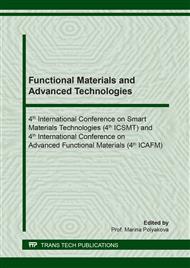[1]
A. Hansmeier, G. W. Meindersma, and A. de Haan, Desulfurization and denitrogenation of gasoline and diesel fuels by means of ionic liquids,, Green Chem., vol. 13, no. 7, p.1907, (2011).
DOI: 10.1039/c1gc15196g
Google Scholar
[2]
R. Meyers, Manual de Procesos de Refinación de Petróleo, 3rd ed. Colombia: The McGraw-Hill Interamericana Editores, (2004).
Google Scholar
[3]
B. Gates and H. Topsøe, Reactivities in deep catalytic hydrodesulfurization: challenges, opportunities, and the importance of 4-methyldibenzothiophene and 4,6-dimethyl dibenzothiophene,, Polyhedron, vol. 16, no. 18, p.3213–3217, Jan. (1997).
DOI: 10.1016/s0277-5387(97)00074-0
Google Scholar
[4]
R. Abro et al., A review of extractive desulfurization of fuel oils using ionic liquids,, RSC Adv., vol. 4, no. 67, p.35302–35317, (2014).
DOI: 10.1039/c4ra03478c
Google Scholar
[5]
S. Zhang, Q. Zhang, and C. Zhang, Extractive Desulfurization and Denitrogenation of Fuels Using Ionic Liquids,, Ind. Eng. Chem. Res., vol. 43, no. 2, p.614–622, (2004).
DOI: 10.1021/ie030561+
Google Scholar
[6]
N. Farzin and A. Mirani, Efficient desulfurization of gasoline fuel using ionic liquid extraction as a complementary process to adsorptive desulfurization,, Pet. Sci., vol. 12, no. 2, p.330–339, (2015).
DOI: 10.1007/s12182-015-0020-2
Google Scholar
[7]
B. Gabrić, A. Sander, M. Cvjetko Bubalo, and D. Macut, Extraction of S- and N-compounds from the mixture of hydrocarbons by ionic liquids as selective solvents.,, ScientificWorldJournal., vol. 2013, p.512953, (2013).
DOI: 10.1155/2013/512953
Google Scholar
[8]
J. H. Kareem, Sulfur Extraction from Oil Using Ionic Liquids,, University of Leicester, (2017).
Google Scholar
[9]
X. Chu et al., Desulfurization of Diesel Fuel by Extraction with [BF4]-based Ionic Liquids,, Chinese J. Chem. Eng., vol. 16, no. 6, p.881–884, (2008).
DOI: 10.1016/s1004-9541(09)60010-0
Google Scholar
[10]
S. Zhang and Z. C. Zhang, Novel properties of ionic liquids in selective sulfur removal from fuels at room temperature,, Green Chem., vol. 4, no. 7, p.376–379, (2002).
DOI: 10.1039/b205170m
Google Scholar
[11]
W.-H. Lo, H.-Y. Yang, and G.-T. Wei, One-pot desulfurization of light oils by chemical oxidation and solvent extraction with room temperature ionic liquids,, Green Chem., vol. 5, no. 5, p.639, (2003).
DOI: 10.1039/b305993f
Google Scholar
[12]
C. Asumana, R. Haque, L. Yu, X. Wu, and X. Chen, Desulfurization of Real Fuel Oils by Extraction with Ionic Liquids Desulfurization of Real Fuel Oils by Extraction with Ionic Liquids,, Sep. Sci. Technol., vol. 48, no. 17, p.2582–2588, (2013).
DOI: 10.1080/01496395.2013.804559
Google Scholar
[13]
Y. Nie, C. Li, A. Sun, H. Meng, and Z. Wang, Extractive Desulfurization of Gasoline Using Imidazolium-Based Phosphoric Ionic Liquids,, Energy Fuels, vol. 20, no. 5, p.2083–2087, (2006).
DOI: 10.1021/ef060170i
Google Scholar
[14]
S. Dharaskar, K. Wasewar, M. Varma, D. Shende, and C. Yoo, Synthesis, characterization and application of 1-butyl-3-methylimidazolium tetrafluoroborate for extractive desulfurization of liquid fuel,, Arab. J. Chem., vol. 9, no. 4, p.578–587, (2016).
DOI: 10.1016/j.arabjc.2013.09.034
Google Scholar
[15]
G. Socrates, Infrared and Raman Characteristic Group Frequencies / Tables and Charts, 3rd ed. Chichester, England: John Wiley & Sons Ltd., (2001).
DOI: 10.1002/jrs.1238
Google Scholar
[16]
F. Rojo, Tablas de Espectroscopía Infrarroja,, UNAM, 2011. [Online]. Available: http://depa.fquim.unam.mx/amyd/archivero/IR-tablas_35276.pdf. [Accessed: 30-Sep-2018].
Google Scholar
[17]
H. Gao, C. Guo, J. Xing, and H. Liu, Deep Desulfurization of Diesel Oil with Extraction Using Pyridinium-Based Ionic Liquids Deep Desulfurization of Diesel Oil with Extraction Using Pyridinium-Based Ionic Liquids,, Sep. Sci. Technol., vol. 47, no. 2, p.325–330, (2012).
DOI: 10.1080/01496395.2011.620583
Google Scholar
[18]
P. Verdía, Diseño y síntesis de Líquidos Iónicos para aplicaciones específicas.,, Universidade de Vigo, (2012).
Google Scholar
[19]
P. S. Kulkarni and C. A. M. Afonso, Deep desulfurization of diesel fuel using ionic liquids : current status and future challenges,, Green Chem., vol. 12, no. 5, p.1139–1149, (2010).
DOI: 10.1039/c002113j
Google Scholar
[20]
B. M. Su, S. Zhang, and Z. C. Zhang, Structural elucidation of thiophene interaction with ionic liquids by multinuclear NMR spectroscopy,, J. Phys. Chem. B, vol. 108, no. 50, p.19510–19517, (2004).
DOI: 10.1021/jp049027l
Google Scholar


